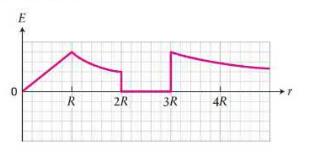A system is composed of two infinitely long concentric cylinders, an outer cylinder (mathrm{O}) and an inner
Question:
A system is composed of two infinitely long concentric cylinders, an outer cylinder \(\mathrm{O}\) and an inner cylinder I. Each is either conducting or nonconducting, and both have a uniform surface or volume charge density. Cylinder \(\mathrm{O}\) is a shell, and cylinder \(\mathrm{I}\) is either solid or a shell. The graph in Figure P24.98 shows the magnitude of the electric field as a function of the radial distance \(r\) from the long central axis of the concentric cylinders. At all values of \(r\), the electric field either is zero or has a nonzero magnitude and is directed away from the long central axis.
(a) Deduce whether the cylinders are conducting or nonconducting, and give the relevant radii \(R\) (inner and outer radii for \(\mathrm{O}\); either one radius or two for I depending on whether it is solid or a shell) in terms of the general radius \(R\) shown in the graph.
(b) What is the ratio of the charge on cylinder I to the charge on cylinder \(\mathrm{O}\) ?
Data from Figure P24.98

Step by Step Answer:





